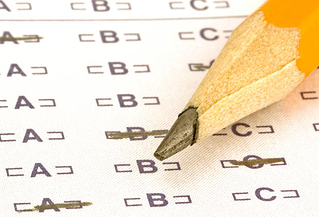“Should I take the GRE or the GMAT” is one of the more frequent lines of questioning we get from students considering working with a GRE tutor. Everyone wants to know if...
GMAT Scores Continue to Rise
 This summer at mba.com, the GMAC released new raw scores to percentile guidance based on nearly 800,000 tests administered from 2014-2017. In the newly released time-period, the average overall score out of 800 has risen by more than 4 points to slightly above 556 from just below 552 for the previous period of 2013-2015. Interestingly, this increase can be almost entirely attributed to improvements in the Quantitative section. For the reporting period ending in 2015, the average GMAT Quantitative raw score was 38.91. In this newly reported data, that score has risen by almost a full ½ point to 39.4. Concurrently, the GMAT Verbal average score improved, too, but only at a factor of about one-tenth that of the quantitative improvement – from 26.8 to 26.86.
This summer at mba.com, the GMAC released new raw scores to percentile guidance based on nearly 800,000 tests administered from 2014-2017. In the newly released time-period, the average overall score out of 800 has risen by more than 4 points to slightly above 556 from just below 552 for the previous period of 2013-2015. Interestingly, this increase can be almost entirely attributed to improvements in the Quantitative section. For the reporting period ending in 2015, the average GMAT Quantitative raw score was 38.91. In this newly reported data, that score has risen by almost a full ½ point to 39.4. Concurrently, the GMAT Verbal average score improved, too, but only at a factor of about one-tenth that of the quantitative improvement – from 26.8 to 26.86.
As for the lower priority sections that do not count toward the 800 score, the Integrated Reasoning average held steady across reporting periods at 4.23 and the Analytical Writing Assessment average score improved slightly to 4.44.
What Do These Percentiles Mean?
Obviously, primarily it means that in aggregate prospective MBA students are much more proficient at the quantitative skills the GMAT purports to test than they are at the tested verbal skills. However, for the individual test taker there are several important ramifications:
- Prioritize Quant to Start: Since the average MBA candidate does so much better on the quantitative section, and the exam is graded on a curve, it’s critically important to focus on Quantitative instruction and practice while aiming to break the 50 percent mark.
- Verbal Presents an Opportunity: Conversely, because the average GMAT student fares comparatively poorly on the verbal section, improvements on this section can separate a savvy MBA candidate from the applicant pack.
- Focus on Verbal for 700+: Because fully 40% of all GMAT test takers get a 46+ raw score on the Quantitative section, and anything above a 51 is exceedingly rare in either section, candidates seeking above a 700 must cultivate additional high-end points by improving performance on Sentence Corrections, Critical Reasoning, and Reading Comprehension.
Use Your Percentile Score to Study Successfully
The GMATPrep software conveniently breaks practice scores down by section. As this score summary clearly shows, not all GMAT 90th percentiles are created equal. No matter what your current score is, remember that raw scores above 51 in the Quantitative section and above 46 in the Verbal are almost statistically impossible due to the adaptive nature of the exam. For this student, that means there is likely only 1 more realistic point of improvement available in the Quant section, but as many as 5-6 points that could still be mined in the Verbal section. The key to GMAT improvement is not only taking as many practice exams as possible, but also using the data from those results to inform how to most effectively allocate your preparation time moving forward.
Of course, there are some excellent online GMAT prep options which help you hone in on your weaker areas to more effectively allocate your time. For example, examPal has a system that analyzes the questions you are missing to identify patterns, and then helps you understand how to start approaching the questions differently.
Maybe, in time, GMAT students will even focus on the Verbal section enough that we start to see those raw scores even out a bit!
About the Author: Stefan Maisnier is the Director of Online Tutoring at MyGuru, and sometimes contemplates the lagging Verbal scores of business school applicants while gazing wistfully at his own Masters of Science in Journalism from Northwestern University.
